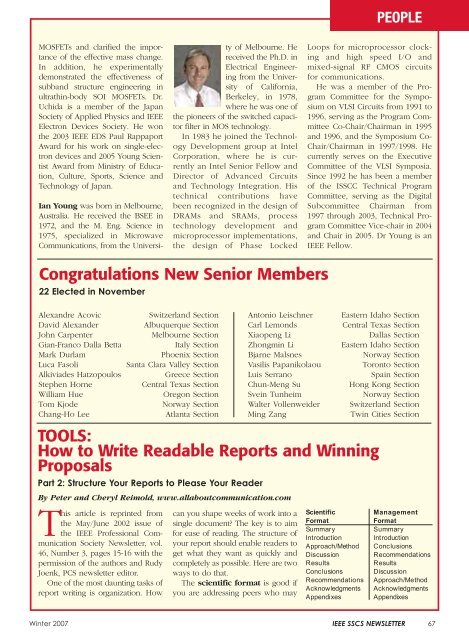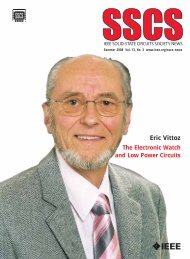The Impact of Dennard's Scaling Theory - IEEE
The Impact of Dennard's Scaling Theory - IEEE
The Impact of Dennard's Scaling Theory - IEEE
- TAGS
- scaling
- www.ieee.org
Create successful ePaper yourself
Turn your PDF publications into a flip-book with our unique Google optimized e-Paper software.
MOSFETs and clarified the importance<br />
<strong>of</strong> the effective mass change.<br />
In addition, he experimentally<br />
demonstrated the effectiveness <strong>of</strong><br />
subband structure engineering in<br />
ultrathin-body SOI MOSFETs. Dr.<br />
Uchida is a member <strong>of</strong> the Japan<br />
Society <strong>of</strong> Applied Physics and <strong>IEEE</strong><br />
Electron Devices Society. He won<br />
the 2003 <strong>IEEE</strong> EDS Paul Rappaport<br />
Award for his work on single-electron<br />
devices and 2005 Young Scientist<br />
Award from Ministry <strong>of</strong> Education,<br />
Culture, Sports, Science and<br />
Technology <strong>of</strong> Japan.<br />
Ian Young was born in Melbourne,<br />
Australia. He received the BSEE in<br />
1972, and the M. Eng. Science in<br />
1975, specialized in Microwave<br />
Communications, from the Universi-<br />
Congratulations New Senior Members<br />
22 Elected in November<br />
Alexandre Acovic Switzerland Section<br />
David Alexander Albuquerque Section<br />
John Carpenter Melbourne Section<br />
Gian-Franco Dalla Betta Italy Section<br />
Mark Durlam Phoenix Section<br />
Luca Fasoli Santa Clara Valley Section<br />
Alkiviades Hatzopoulos Greece Section<br />
Stephen Horne Central Texas Section<br />
William Hue Oregon Section<br />
Tom Kjode Norway Section<br />
Chang-Ho Lee Atlanta Section<br />
This article is reprinted from<br />
the May/June 2002 issue <strong>of</strong><br />
the <strong>IEEE</strong> Pr<strong>of</strong>essional Communication<br />
Society Newsletter, vol.<br />
46, Number 3, pages 15-16 with the<br />
permission <strong>of</strong> the authors and Rudy<br />
Joenk, PCS newsletter editor.<br />
One <strong>of</strong> the most daunting tasks <strong>of</strong><br />
report writing is organization. How<br />
ty <strong>of</strong> Melbourne. He<br />
received the Ph.D. in<br />
Electrical Engineering<br />
from the University<br />
<strong>of</strong> California,<br />
Berkeley, in 1978,<br />
where he was one <strong>of</strong><br />
the pioneers <strong>of</strong> the switched capacitor<br />
filter in MOS technology.<br />
In 1983 he joined the Technology<br />
Development group at Intel<br />
Corporation, where he is currently<br />
an Intel Senior Fellow and<br />
Director <strong>of</strong> Advanced Circuits<br />
and Technology Integration. His<br />
technical contributions have<br />
been recognized in the design <strong>of</strong><br />
DRAMs and SRAMs, process<br />
technology development and<br />
microprocessor implementations,<br />
the design <strong>of</strong> Phase Locked<br />
can you shape weeks <strong>of</strong> work into a<br />
single document? <strong>The</strong> key is to aim<br />
for ease <strong>of</strong> reading. <strong>The</strong> structure <strong>of</strong><br />
your report should enable readers to<br />
get what they want as quickly and<br />
completely as possible. Here are two<br />
ways to do that.<br />
<strong>The</strong> scientific format is good if<br />
you are addressing peers who may<br />
PEOPLE<br />
Antonio Leischner Eastern Idaho Section<br />
Carl Lemonds Central Texas Section<br />
Xiaopeng Li Dallas Section<br />
Zhongmin Li Eastern Idaho Section<br />
Bjarne Malsnes Norway Section<br />
Vasilis Papanikolaou Toronto Section<br />
Luis Serrano Spain Section<br />
Chun-Meng Su Hong Kong Section<br />
Svein Tunheim Norway Section<br />
Walter Vollenweider Switzerland Section<br />
Ming Zang Twin Cities Section<br />
TOOLS:<br />
How to Write Readable Reports and Winning<br />
Proposals<br />
Part 2: Structure Your Reports to Please Your Reader<br />
By Peter and Cheryl Reimold, www.allaboutcommunication.com<br />
Loops for microprocessor clocking<br />
and high speed I/O and<br />
mixed-signal RF CMOS circuits<br />
for communications.<br />
He was a member <strong>of</strong> the Program<br />
Committee for the Symposium<br />
on VLSI Circuits from 1991 to<br />
1996, serving as the Program Committee<br />
Co-Chair/Chairman in 1995<br />
and 1996, and the Symposium Co-<br />
Chair/Chairman in 1997/1998. He<br />
currently serves on the Executive<br />
Committee <strong>of</strong> the VLSI Symposia.<br />
Since 1992 he has been a member<br />
<strong>of</strong> the ISSCC Technical Program<br />
Committee, serving as the Digital<br />
Subcommittee Chairman from<br />
1997 through 2003, Technical Program<br />
Committee Vice-chair in 2004<br />
and Chair in 2005. Dr Young is an<br />
<strong>IEEE</strong> Fellow.<br />
Winter 2007 <strong>IEEE</strong> SSCS NEWSLETTER 67




